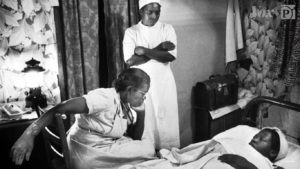Most Drugs Aren’t Tested on Pregnant Women. This Anti-Nausea Cure Shows Why That’s a Problem.
For years, Zofran was the most popular morning-sickness medication in the U.S. Now it’s being blamed for causing birth defects. The larger issue is a drug-safety system that excludes women from clinical trials, potentially putting them and their babies at risk. Chriggy / CC BY-NC-ND 2.0
1
2
Chriggy / CC BY-NC-ND 2.0
1
2
Meanwhile, Marquita Smiley and other women are often left with no clear options or answers — and little or no recourse if something goes very wrong. It’s an awful position to be in, Smiley said. “I’m trying to find the words.”
Not so long ago, doctors viewed nausea and vomiting of pregnancy (the medical term for morning sickness, abbreviated as NVP) as largely a psychological problem, at its worst a sign that a woman was so unhappy being pregnant she literally wanted to throw up her fetus. Now, the key culprit is believed to be the hormone human chorionic gonadotropin, which is produced in the placenta and surges through a woman’s body as the embryo begins its rapid growth. Studies suggest that some nausea is actually a healthy sign, with mothers who suffer from it less likely to miscarry or go into premature labor. But up to 2 percent of pregnant women develop hyperemesis gravidarum (HG), nausea and vomiting so serious it can require hospitalization — Charlotte Bronte is believed to have died from it. As with so much else about pregnancy, the long-term effects of hyperemesis are mostly unknown: “Because they see HG as a maternal disorder that lasts three months, they don’t fund the research for it,” said Kimber MacGibbon, founder of the HER Foundation, a patient advocacy group.
Three decades before Zofran arrived on the scene, thalidomide seemed like an answer. The German drug was marketed as a sedative and sleeping pill. But it also eased nausea and was believed to pose no dangers to human fetuses — until women began giving birth to babies with severely deformed limbs. After thalidomide was banned in the early 1960s, doctors and women relied on a drug called Bendectin that had received FDA approval in the 1950s specifically for morning sickness and had a long track record for safety; still, lawsuits eventually blamed it for fetal harm, ranging from skeletal malformations to blood disorders and cancer. The claims proved to be unfounded, but in 1983, the litigation-weary manufacturer voluntarily yanked it from the market. For the next 30 years, there was no FDA-approved treatment for NVP.
Other reproductive-health scandals erupted over the cancer-causing synthetic estrogen DES, which was prescribed to prevent miscarriages, and the potentially deadly Dalkon Shield intrauterine device, used to prevent pregnancy. In their aftermath, the ethical and scientific pendulum swung in the direction of extreme caution.
Pharmaceutical companies and regulators concluded that the best way to avoid injuring women and their offspring — and the resulting crush of lawsuits — was to stop doing research on all women. “The fear of bad outcomes in pregnancy led to this sort of general exclusion,” said Wood, the former FDA official. In 1977, the FDA issued formal guidelines stating that women of “childbearing potential” — i.e., anyone who had not gone through menopause or been surgically sterilized — could only be included in late-stage clinical trials, after the safety and effectiveness of a drug had already been established (a rule widely interpreted as “never”).
Thanks in large part to the furious lobbying of feminists and anti-AIDS activists, the FDA finally reversed its stance against most women in research in 1993. But pregnancy remained a conundrum. The influential Institute of Medicine argued in a report co-edited by Faden, that “If a drug is going to be used in pregnant women, then the availability of safety and effectiveness information” is critical, including “adequate information about the risks and benefits.” Moreover, pregnant women should be “treated as competent adults capable of making their own decisions.”
Over the next two decades, the FDA encouraged the pharmaceutical industry in numerous ways. It ran a series of meetings and drafted a “guidance” on how to ethically determine the biochemical and physiological effects of drugs on the pregnant body. It spent years revising labeling rules on drug safety during pregnancy (the final version was issued in 2014) and pressed companies to establish pregnancy registries to simplify tracking adverse outcomes in drugs.
Yet, widespread aversion to prenatal research persisted. The National Institutes of Health continued to categorize pregnant women as “vulnerable,” with a “questionable” capacity to give informed consent — in the same category as kids, prisoners, and the mentally disabled. Conducting research on mothers-to-be was complicated and costly, and women themselves were often hesitant to sign on. “We honestly haven’t really addressed the issue of actively trying to recruit pregnant women into clinical trials,” a research expert for the drug industry said in a recent interview, speaking on the condition of anonymity. A 52-page document by the Pharmaceutical Research and Manufacturers of America, outlining principles for conducting clinical trials and revised in 2015, doesn’t contain a single reference to pregnancy.
Physicians responded by doing what they have always done: They prescribed drugs to pregnant patients “off label,” and shared the benefits and potential risks in medical journals and at conferences. The scientific establishment and the FDA consider this part of the basic practice of medicine, beyond the scope of regulators. The result was something of a vicious cycle, Faden said. “If your product eventually will be used in this population anyway, off label, what’s your incentive for testing the drug in pregnant women before it’s approved?”
Zofran’s introduction in 1991 occurred in the midst of this research vacuum. The drug worked by blocking the action of the chemical serotonin in the brain’s so-called vomiting center. It had been extensively tested on cancer and surgical patients, and on pregnant rats and rabbits. These studies showed “no evidence of impaired fertility or harm to the fetus,” the FDA-approved package insert said. But because animal studies are imperfect predictors of human toxicity and there were “no adequate and well-controlled studies in pregnant women,” the drug “should be used during pregnancy only if clearly needed,” the label added.
Plenty of ob/gyns believed it was needed — desperately. The journal Lancet soon published letters from doctors in Greece and Britain who had used Zofran on patients with severe hyperemesis. Physicians in Hong Kong described a patient so weak that she had considered having an abortion — until the drug turned her pregnancy around. The HER Foundation’s MacGibbon had HG with both her kids, and the drug was such a salvation that she and her husband joked about naming their daughter “Zofrana.” As a registered nurse, she understood the off-label dilemma, “but I knew that if I didn’t [take it], literally, I would just sit there and puke until I couldn’t breath.”
By the time Marquita Smiley was pregnant with Zaidan in 2013, Zofran/ondansetron was available in both liquid and pill form and as a generic from 30 or so manufacturers. The online price for 30 pills had plummeted from nearly $800 to $26. Last year, more than 21 million prescriptions were filled in the U.S. for all uses of the drug, according to an analysis by IMS Health — 10 times as many as in 2006. Doctors were no longer reserving the drug for only the most difficult cases, said Smiley’s lawyer, Don McKenna of the Birmingham law firm Hare Wynn. “It got to the point where if anyone complained of an upset stomach, they would get a prescription.”
Although doctors may decide to prescribe a medication for unapproved uses, it’s illegal for drug companies to encourage them to do it. In 2012, the U.S. Justice Department announced that GlaxoSmithKline had crossed the line.
The allegations originated with ex-Glaxo marketing execs turned whistleblowers. The DOJ accused the company of engaging in all kinds of banned behavior to drive up sales — plying doctors with Caribbean vacations and hunting trips, misreporting clinical trial findings to a medical journal, withholding safety data from the FDA. The most serious, criminal charges covered the antidepressants Paxil and Wellbutrin and the diabetes drug Avandia. But in a civil settlement, DOJ said Glaxo had also spread “unsubstantiated and/or false representations” about Zofran’s use for morning sickness and “paid illegal remuneration” to doctors to promote and prescribe the drug, in violation of federal anti-kickback laws. Glaxo didn’t admit any wrongdoing where Zofran was concerned, but it pleaded guilty to fraud in connection with other drugs and paid a $3 billion fine, the largest ever levied against a drug maker. (Read ProPublica’s reporting about another drug in the civil case, the asthma medication Advair, here.)
The DOJ case hit the news at a delicate moment. For years, reports in medical journals raised few concerns about the Zofran’s use in pregnancy, but they were small and frequently observational — hardly the scientific gold standard. By 2012, however, large-enough numbers of pregnant mothers had used the drug to conduct more meaningful analyses. Researchers associated with the National Birth Defects Prevention Study found an increased risk of cleft palate in infants whose mothers had used ondansetron (a separate, unpublished analysis detected a “modest increased risk” of the type of heart problem suffered by Marquita Smiley’s son). Next came studies based on medical registries in Denmark and Sweden that tracked every pregnancy in those countries going back to the 1990s. One found no difference in birth defects between the Zofran-exposed and unexposed babies; another found an elevated risk — up to twice as high — of hole-in-the-heart defects.
Among scientists, the inconsistent studies triggered calls for more research but no major alarms. Birth defects afflict 3 percent of babies, and heart defects are the most common among them. If ondansetron does harm the fetus, “It absolutely can’t be anything huge or we would have already seen it,” said Christina Chambers, a professor at the University of California, San Diego School of Medicine who is a leading expert on environmental exposures and pregnancy.
Plaintiffs lawyers, though, thought they saw plenty of red flags. Over the next couple of years, they hired their own experts and began digging through everything from adverse-event reports filed with the FDA (more than 450 involving prenatal exposures), to the LinkedIn profiles of Zofran sales people, to obscure Japanese medical journals in which scientists working for Glaxo had published animal studies in the early 1990s.
By this spring, parents had filed more than 200 lawsuits, alleging that Zofran caused heart defects, cleft palates, and kidney problems in babies exposed to the drug in utero; in a few instances, the babies died. Lawyers contended there might be many more cases but for recent U.S. Supreme Court rulings that make it almost impossible for consumers in all but a few states to sue for injuries if the medication at issue was a generic version of a brand-name pill, as ondansetron is for Zofran. One state whose courts did allow such lawsuits was Alabama — until legislators there rewrote the law in 2015. Marquita Smiley, who took generic ondansetron, filed her lawsuit last fall, just before the courtroom doors slammed shut.
In a written statement, Glaxo said the allegations linking Zofran to birth defects are “entirely unfounded,” and pointed to the FDA’s rejection last fall of a citizen’s petition that had sought stronger pregnancy warnings on the label. The company said doctors have a right to “assess the health care needs of their patients and apply their own knowledge, training, and experience in deciding whether the therapeutic benefits of a medicine outweigh the potential risks in each patient.”
But plaintiffs’ lawyers argue that drug makers have a heightened responsibility to assure that medications likely to be used in pregnancy are safe — especially if they are used to treat a condition as common as morning sickness, and if they are marketed off-label.
“When you throw a stone in the water, you have to expect there will be ripples,” said Tobias Millrood, a Philadelphia lawyer who is one of the lead counsels. “It’s really quite that simple.”
Under Alabama law, a woman who uses illicit drugs while pregnant can be arrested, prosecuted and stripped of her parental rights — even if she was just using marijuana to treat her morning sickness. Smiley’s agency, the state Department of Human Resources, is the one often called upon to investigate allegations that pregnant women and new mothers have chemically endangered their babies. Smiley doesn’t handle those kinds of cases, but she knows irony when she sees it: A woman could face 10 years in prison for endangering her unborn child with drugs, while a huge corporation could put children at risk with a drug that’s never been approved for use in pregnancy.”It’s crazy,” she said.
In her lawyers’ office one late winter morning, Zaidan was sweet-tempered and surprisingly sturdy, exploring the unfamiliar environment with sippy cup in hand. But his skin was blotchy and his hair had been falling out. The transplant drugs have wreaked havoc on his immune system, and he spent most of March in the hospital with breathing and other problems. As much as Smiley worries about his physical health, she’s just as concerned about his cognitive and emotional development. “He had a lot of loss of oxygen to his brain early on,” she said. She has to protect him from infections, which means keeping him way from a lot of people, “and I know that’s bad because he needs social skills.” Thanks to her job, she knows where to get help: “The social worker in me had him sign up for early intervention….I’m on the receiving end of the services now.”
With so much to worry about, she hasn’t been paying much attention to the lawsuit. Glaxo lost a bid earlier this year to have the cases dismissed, and now the litigation is in its discovery phase: “GSK has to put all its cards on the table and say … ‘This is everything we knew,'” attorney Don McKenna said. The latest research has not gone in the plaintiffs’ favor: A new study looking at birth outcomes in more than 1,000 women who took Zofran or ondansetron for hyperemesis suggested that HG itself, and not the drug, might be to blame for birth defects.
Back in Washington, D.C., there has been quiet movement on the larger issue of research and pregnancy. Bipartisan bills introduced this spring in the Senate and the House of Representatives would establish a task force on research specific to pregnant women and (in the case of the House legislation) require annual updates from the FDA. The FDA is scheduled to issue its own draft guidance entitled “Pregnant Women in Clinical Trials — Scientific and Ethical Considerations” later in the year.
The agency also has approved a new drug for morning sickness called Diclegis — basically, the long-abandoned Bendectin under a new name. Last year the American College of Obstetricians and Gynecologists revised its practice bulletin, urging doctors to prescribe Diclegis as the first line of defense against NVP and ondansetron only after weighing the benefits against the risks. But Diclegis is less powerful, more costly, and Smiley and her lawyers believe women are still being given ondansetron out of habit.
Recently, she saw an old friend at church who happened to be pregnant. “She said, ‘I’m having these really bad spells with nausea. It’s hard for me to get out of bed. It’s hard for me to go to work.'”
Smiley told her friend about Zaidan and everything her family had been through. “I was like, ‘Hey, whatever you do, I don’t know if there’s any truth to this, but please find something else to take.'”
ProPublica is a Pulitzer Prize-winning investigative newsroom.
Your support matters…Independent journalism is under threat and overshadowed by heavily funded mainstream media.
You can help level the playing field. Become a member.
Your tax-deductible contribution keeps us digging beneath the headlines to give you thought-provoking, investigative reporting and analysis that unearths what's really happening- without compromise.
Give today to support our courageous, independent journalists.





You need to be a supporter to comment.
There are currently no responses to this article.
Be the first to respond.